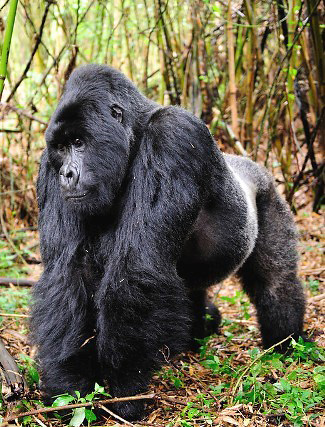

A magnificent silverback Mountain Gorilla in Rwanda by Max Chiswick.
- Close encounters with Mountain Gorillas
- And possibly Chimpanzees
- Several species of monkey including Black-and-white Colobus, Golden and L’Hoest’s
- And African Elephant, Hippopotamus and African Buffalo
- Some of Africa’s and the world’s most spectacular localized birds such as Ruwenzori Turaco, Red-collared Mountain-babbler and Purple-breasted Sunbird, just a few of the 25 Albertine Rift Endemics present
- And some of Africa’s and the world’s most spectacular other birds including African Fish-eagle, Goliath Heron,
Great Blue Turaco and Black-and-white-casqued
Hornbill, with a chance of Shoebill - All in some savanna but mainly forested mountains with one of the largest remaining tracts of montane forest in the whole of Africa
- Read Gorillas in the Mist, the wonderful book by Dian Fossey who carried out most of her research here, try to get some sleep, meet the rangers in the morning, listen to their instructions carefully, join the small group of fellow trekkers and head off with high anticipation and overflowing adrenalin along the muddy and sometimes slippery switchback trails up through the lush, damp, sometimes misty, forest on the slopes of the Virunga Mountains in Volcanoes National Park, Rwanda. One to five hours later, the guides, having spoken on their radios to the trackers who have been out since dawn, will stop. The troop is near and more often than not the first one to emerge from the undergrowth will be the biggest, the magnificent silverback, and visitors seeing him for the first time will more likely than not stand open-mouthed in awe … not in fright … at his huge domed head, massive shoulders, great bare chest and peaceful all-consuming presence, just a few paces away. Then his family will appear and the allotted hour with Mountain Gorillas will pass in what seems like seconds, arguably the most awesome wildlife experience will be over and your life may have changed for ever.
- The more open forest often frequented by the Mountain Gorillas of Rwanda usually make them easier to see than those in Uganda but the much shyer Chimpanzees are yet to be fully habituated to human visitors in Rwanda so they are usually easier to see in Uganda.
Best Birds and other wildlife in Rwanda
Birds
Near-endemics
Rwanda, Burundi, Uganda and DRC 23 Handsome Francolin, Rwenzori Turaco, Dwarf Honeyguide, Rwenzori Batis, Albertine Sooty Boubou, Stripe-breasted Tit, Grauer’s Warbler, Rwenzori Apalis, Black-faced Apalis, Grauer’s Swamp-warbler, Red-faced Woodland-warbler, Neumann’s (Short-tailed) Warbler, Red-collared Mountain-babbler, Yellow-eyed Black-flycatcher, Archer’s Robin-chat, Red-throated Alethe, Blue-headed Sunbird, Purple-breasted Sunbird, Rwenzori (Stuhlmann’s) Double-collared Sunbird, Regal Sunbird (range also reaches Tanzania), Strange Weaver, Dusky Crimsonwing and Shelley’s Crimsonwing.
Rwanda, Burundi, Uganda and Tanzania 1 Red-faced Barbet.
Rwanda and DRC 1 Albertine (African Barred) Owlet.
Rwanda, Burundi, DRC and Tanzania 1 Kungwe Apalis.
(The 36 Albertine Rift Endemic Birds are Handsome Francolin, Prigogine's Nightjar, Rwenzori Turaco, Congo Bay-owl, Albertine Owlet, Dwarf Honeyguide, Grauer's Broadbill, Grauer's Cuckooshrike, Yellow-crested Helmetshrike, Rwenzori Batis, Albertine Sooty Boubou, Stripe-breasted Tit, Lendu Crombec, Grauer's Warbler, Rwenzori Apalis, Black-faced Apalis, Kabobo Apalis, Kungwe Apalis, Grauer's Swamp-warbler, Prigogine's Greenbul, Red-faced Woodland-warbler, Neumann's (Short-tailed) Warbler, Red-collared Mountain-babbler, Chapin's Mountain-babbler, Chapin's Flycatcher, Yellow-eyed Black-flycatcher, Archer's Robin-chat, Red-throated Alethe, Blue-headed Sunbird, Purple-breasted Sunbird, Rwenzori (Stuhlmann’s) Double-collared Sunbird, Regal Sunbird, Rockefeller's Sunbird, Strange Weaver, Dusky Crimsonwing and Shelley's Crimsonwing)
Other specialities
Papyrus Gonolek, White-winged Swamp-warbler, Rwenzori (African) Hill-babbler and Papyrus Canary. Also a chance of Shoebill.
Others
Helmeted Guineafowl, African Darter, Hamerkop, Goliath, Madagascar Pond (mostly May-Oct) and Rufous-bellied Herons, White-headed Vulture, Bateleur,
African Fish-eagle, African Crowned, Long-crested and Martial Eagles, Black Crake, Black-bellied Bustard, Grey Crowned Crane, African Jacana, Long-toed
and Senegal Lapwings, Meyer’s Parrot, Black-billed, Great Blue, Purple-crested and Ross's Turacos, Bare-faced Go-away-bird, Barred Long-tailed Cuckoo,
Scarce Swift, mousebirds, Bar-tailed and Narina Trogons, kingfishers including Giant, bee-eaters including Cinnamon-chested, Lilac-breasted Roller,
African Hoopoe, Green Woodhoopoe, hornbills, Double-toothed and Red-faced Barbets, woodpeckers, Chin-spot Batis, White-crested Helmetshrike, Doherty’s,
Lagden’s and Sulphur-breasted Bushshrikes, Black-headed Gonolek, Grey-backed Fiscal, Montane Oriole, Blue-mantled and White-bellied Crested-flycatchers,
African Paradise-flycatcher, Mountain Greenbul, apalises, Banded Prinia, Red-faced Crombec, Violet-backed Hyliota, flycatchers, Arnot’s and Sooty Chats,
robin-chats, White-starred Robin, Equatorial Akalat, scrub-robins, Splendid Starling, Red-billed and Yellow-billed Oxpeckers, sunbirds including
Red-chested, Yellow-throated Longclaw, Mountain Wagtail, Golden-breasted Bunting, weavers and waxbills. Also a chance of Red-chested Owlet.
Mammals
Mountain Gorilla, Chimpanzee, Angola/Black-and-white/Ruwenzori Colobus Monkey (possibly the largest troop in the
world, estimated to contain 500 animals, lives in Nyungwe Forest NP), Grey-cheeked Mangabey, Blue, Golden (Blue), L’Hoest’s and Silver (Blue) Monkeys,
African Elephant, Hippopotamus, African Buffalo, Burchell's Zebra, Olive Baboon, Bushbaby (Greater Galago), Eland, Waterbuck, Topi, Impala, Bohor Reedbuck,
Bushbuck and Oribi. Also a chance of Giraffe (introduced), Spotted Hyaena, Sitatunga, Roan and Sable, and an outside chance of Dent’s (Mona), Owl-faced and
Red-tailed Monkeys.
Reptiles, Amphibians and Fish
Nile Crocodile. Also a chance of Ruwenzori Side-striped Chameleon.
Best Sites for Birds, Gorillas and other wildlife in Rwanda
- Volcanoes NP Mountain Gorilla and
Golden Monkey. - Nyungwe Forest NP 25 Albertine Rift Endemics, as well as Black-billed and Great Blue Turacos, Bar-tailed and Narina Trogons, White-headed Woodhoopoe, Black-and-white-casqued Hornbill, Doherty’s Bushshrike, White-bellied Robin-chat, White-starred Robin, Montane Oriole, Green White-eye (split from African Yellow White-eye), possibly the largest troop of Angola/Black-and-white Colobus Monkeys in the world, estimated to contain 500 animals, Grey-cheeked Mangabey, and L’Hoest’s and Silver Monkeys. Also a chance of Red-chested Owlet and Chimpanzee (most likely in Oyamodongo Forest), and an outside chance of Dent’s (Mona) (most likely in Oyamodongo Forest), Owl-faced and Red-tailed Monkeys.
- Nyabarongo River, near Kigali Papyrus Gonolek, White-winged Swamp-warbler and Papyrus Canary.
- Akagera NP African Elephant, Hippopotamus, African Buffalo, Nile Crocodile, Burchell's Zebra, Olive Baboon, Waterbuck, Topi, Impala, African Darter, Goliath and Rufous-bellied Herons, White-headed Vulture, African Fish and Martial Eagles, Black-bellied Bustard, Grey Crowned Crane, Long-toed and Senegal Lapwings, Purple-crested and Ross’s Turacos, Giant Kingfisher, Lilac-breasted Roller, Red-faced Barbet and Sooty Chat. Also a chance of Shoebill, Giraffe (introduced), Spotted Hyaena, Sitatunga, Roan and Sable.

Chimpanzee by Alice Perry.
Best Times for Birds, Gorillas and other wildlife in Rwanda
The peak time to visit Rwanda is during the long dry season from June to September. The wettest times of the year are usually March to May and October to December.
Recommended Bird Books etc. for Rwanda
Field Guide to the Birds of East Africa by T Stevenson and J Fanshawe. Helm, due 2020 (Second Edition).
Birds of Africa south of the Sahara by I Sinclair and P Ryan. C Struik, 2011 (Second Edition).
The Kingdon Field Guide to African Mammals by J Kingdon. Bloomsbury, 2015 (Second Revised Edition).
The Kingdon Pocket Guide to African Mammals by J Kingdon. Bloomsbury, 2016 (Second Edition).
Bradt Travel Guides: East African Wildlife by P Briggs. Bradt, 2015 (Second Edition).
Watching Wildlife: East Africa by M D Firestone et al. Lonely Planet, 2009 (Second Edition).
Gorillas in the Mist by Dian Fossey. Phoenix, 2001.
Apps etc.
The Kingdon Guide to African Mammals.
Audubon African Wildlife.
eGuide to Birds of East Africa.
Where to watch birds in Africa by N Wheatley. Helm, 1995.
Don’t know which country/countries to visit in Africa? Then it may be worth considering taking a look at this book, written by this website’s author. It is many years old of course but it still provides a starting point, an overview and a guiding light to the best birds and the best places to look for them on the continent, and could save hours of searching for similar information on the internet. However, it is important to check more up-to-date sources for sites which have been opened up, sites and species which have been discovered, lodges that have been built etc. since the book was published.
Birding and Wildlife Trip Reports for Rwanda
Many trip reports, some for Rwanda, are posted on the websites listed here. On some of these websites some reports are independent and some are posted by tour companies who organize tours to Rwanda. These tour companies and others also post their own reports on their websites, which are listed under 'Some Organized Tours to Rwanda' below.
- The best website for trip reports is CloudBirders
- but these are also worth a look
- Birdtours
- Fatbirder
- Jon Hornbuckle
- Mammal Watching
Local bird, gorilla trekking and wildlife guides in Rwanda
The costs of organized tours partly reflect the quality of the tour leaders. Some leaders are certainly better than others and many companies claim their leaders are the best but even the best rely at least to some extent on the exceptional skills of the local guides they employ. If you are travelling independently, employing such local guides will greatly increase your chances of seeing the wildlife you wish to see.
Accommodation for birders and gorilla trekkers in Rwanda
Some Organized Tours for birds, gorillas and other wildlife to Rwanda
There are many tour companies who organize tours to see mammals, birds, other wildlife and other natural wonders. The cost of these tours vary considerably according to such variables as the airlines used, the number of days the tours last, the number of sites visited, the number of people in the group (an important consideration if you wish to see such wildlife as rainforest mammals and birds), the number of tour leaders, the standard of accommodation and transport, and the percentage profit the company hopes to make. Generally, where the number of days tours last and the number of sites visited are similar, the cheapest tours are those that use the cheapest airlines, accommodation and local transport, that have the largest groups with the least number of leaders, and that make the least amount of profit. The most expensive tours tend to be those which are exceptionally long, use the most expensive accommodation (ridiculously lavish in some cases, even for single nights) and which make the most profit. Some tour costs partly reflect the quality of the tour leaders. Some leaders are certainly better than others and many companies claim their leaders are the best but even the best rely at least to some extent on the exceptional skills of the local guides they employ.
While tour companies organize tours with set itineraries many also organize custom tours for individuals and private groups who instead of taking a tour with a set itinerary want to follow their own itinerary to suit their own personal tastes, whether it be mammals, birds, other wildlife, other natural wonders or even man-made attractions, or a mixture of them all. Many organized tours with set itineraries are also fast-paced and target as many species as possible, whether they are mammals, birds or other wildlife or everything, which usually leaves little time to enjoy the best sites and individual species, but on a custom tour those taking part can specify the pace and the sites and species they wish to concentrate on. Custom tours also suit people who like to travel with people they already know, rather than with a group of strangers, and they are popular with people with partners with different interests. Individuals, partners and small groups will almost certainly have to pay more for a custom tour than an organized tour with a set itinerary but a large group of friends may be able to travel for less than the price quoted for a set tour.
Tour companies who run organized tours to Rwanda include the following. Many of these also offer custom tours.
- Shoebill Safaris
- Shoebill Safaris is one of the leading eco-tour operators for bird watching, gorilla tracking and safaris in East Africa. From swamps and tropical forest to the Rift Valley you are sure to record as many species as your eyes can see in Kenya, Rwanda, Tanzania and Uganda.
- Sunbird
- Wildlife Worldwide

